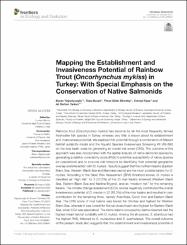| dc.contributor.author | Yoğurtçuoğlu, Baran | |
| dc.contributor.author | Bucak, Tuba | |
| dc.contributor.author | Güler Ekmekçi, Fitnat | |
| dc.contributor.author | Kaya, Cüneyt | |
| dc.contributor.author | Tarkan, Ali Serhan | |
| dc.date.accessioned | 2021-03-04T07:43:18Z | |
| dc.date.available | 2021-03-04T07:43:18Z | |
| dc.date.issued | 2021 | en_US |
| dc.identifier.issn | 2296-701X | |
| dc.identifier.uri | https://doi.org/10.3389/fevo.2020.599881 | |
| dc.identifier.uri | https://hdl.handle.net/20.500.12809/8988 | |
| dc.description.abstract | Rainbow trout (Oncorhynchus mykiss) has become by far the most frequently farmed freshwater fish species in Turkey, whereas very little is known about its establishment and invasiveness potential. We explored this potential through a combination of Maxent habitat suitability model and the Aquatic Species Invasiveness Screening Kit (AS-ISK) on the river basin scale by generating an overall risk score (ORS). The outcome of this approach was also incorporated with the spatial analysis of native salmonid species by generating a relative vulnerability score (RVS) to prioritize susceptibility of native species (or populations) and to propose risk hotspots by identifying their potential geographic overlap and interaction with O. mykiss. Results suggest that the northern basins (Eastern Black Sea, Western Black Sea and Marmara basins) are the most suitable basins for O. mykiss. According to the Basic Risk Assessment (BRA) threshold scores, O. mykiss is classified as "high risk" for 3 (12.0%) of the 25 river basins screened (Western Black Sea, Eastern Black Sea and Maritza-Ergene), and as "medium risk" for the remaining basins. The climate change assessment (CCA) scores negatively contributed the overall invasiveness potential of O. mykiss in 22 (88.0%) of the river basins and resulted in zero contribution for the remaining three, namely Aras-Kura, coruh river and Eastern Black Sea. The ORS score of river basins was lowest for Orontes and highest for Western Black Sea, whereas it was lowest for Konya-closed basin and highest for Eastern Black Sea, when CCA was associated. The micro-basins occupied by Salmo rizeensis had the highest mean habitat suitability with O. mykiss. Among the all species, S. abanticus had the highest RVS, followed by S. munzuricus and S. euphrataeus. The overall outcome of the present study also suggests that the establishment and invasiveness potential of O. mykiss may decrease under future (climate warmer) in Turkey, except for the northeast region. This study can provide environmental managers and policy makers an insight into using multiple tools for decision-making. The proposed RVS can also be considered as a complementary tool to improve IUCN red list assessment protocols of species. | en_US |
| dc.item-language.iso | eng | en_US |
| dc.publisher | FRONTIERS MEDIA | en_US |
| dc.relation.isversionof | 10.3389/fevo.2020.599881 | en_US |
| dc.item-rights | info:eu-repo/semantics/openAccess | en_US |
| dc.subject | Aquaculture | en_US |
| dc.subject | Aquatic species invasiveness screening kit | en_US |
| dc.subject | Maxent habitat suitability model | en_US |
| dc.subject | Climate change | en_US |
| dc.subject | Invasiveness potential | en_US |
| dc.title | Mapping the Establishment and Invasiveness Potential of Rainbow Trout (Oncorhynchus mykiss) in Turkey: With Special Emphasis on the Conservation of Native Salmonids | en_US |
| dc.item-type | article | en_US |
| dc.contributor.department | MÜ, Su Ürünleri Fakültesi, Su Ürünleri Temel Bilimleri Bölümü | en_US |
| dc.contributor.authorID | 0000-0001-8628-0514 | en_US |
| dc.contributor.institutionauthor | Tarkan, Ali Serhan | |
| dc.identifier.volume | 8 | en_US |
| dc.relation.journal | FRONTIERS IN ECOLOGY AND EVOLUTION | en_US |
| dc.relation.publicationcategory | Makale - Uluslararası Hakemli Dergi - Kurum Öğretim Elemanı | en_US |


















